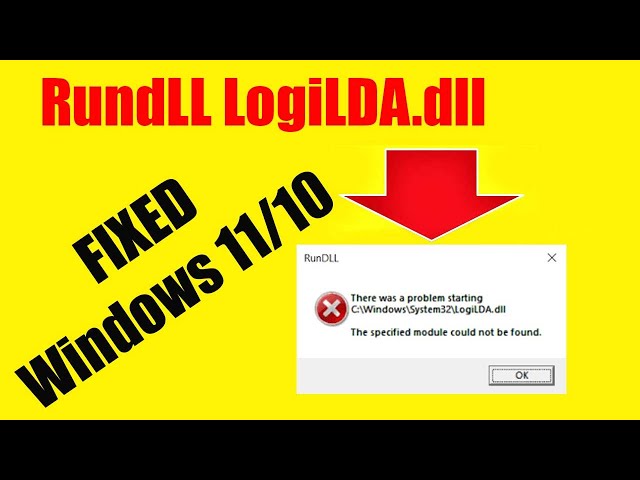The Mysteries of logilda.dll: A Comprehensive Guide
Understanding logilda.dll
What is logilda.dll?
Logilda.dll is a dynamic link library file that plays a crucial role in the Windows operating system. It is specifically designed to manage and facilitate the functionalities of Logitech devices, such as keyboards, mice, and other peripherals.

How does logilda.dll work?
Logilda.dll works by acting as a bridge between Logitech devices and the operating system. It enables the communication and synchronization of device-specific functions, allowing users to fully utilize their Logitech hardware. This DLL file integrates with the Windows system processes to ensure seamless interaction between Logitech devices and the operating system.
Common locations and versions of logilda.dll
Logilda.dll is typically located in the “C: Program FilesLogitech” or “C: WindowsSystem32” directories. The specific location may vary depending on the Logitech software installation and the Windows version.
Various versions of logilda.dll exist, and their compatibility depends on the specific Logitech device and the Windows operating system. It is important to ensure that the version of logilda.dll matches the Logitech software and the Windows version to avoid compatibility issues.
Is logilda.dll a virus or malware?
No, logilda.dll is not a virus or malware. It is a legitimate DLL file provided by Logitech for the proper functioning of their devices. However, it is important to note that some malware or viruses may disguise themselves as logilda.dll to deceive users. It is crucial to verify the authenticity of the file and ensure it is obtained from a trusted source. Regularly scanning your system with reliable antivirus software can help identify any potential threats.
Troubleshooting logilda.dll Issues
Common logilda.dll error messages and their meanings
When encountering Gilda. all-related issues, you may come across several error messages, each indicating a specific problem. Some common error messages include:
“logilda.dll not found” – This error suggests that the logilda.dll file is missing from its expected location.
“logilda.dll is corrupt” – This error message indicates that the logilda.dll file has become damaged or compromised.
“logilda.dll failed to load” – This error occurs when the operating system is unable to load the logilda.dll file properly.
Understanding the meanings behind these error messages can help in diagnosing and resolving logilda.dll issues effectively.
Resolving logilda.dll errors
To resolve common logilda.dll errors, you can follow these steps:
Update Logitech drivers: Outdated or incompatible drivers can cause logilda.dll errors. Visit the Logitech website and download the latest drivers for your specific device model and Windows version.
Reinstall Logitech software: Uninstall the existing Logitech software, restart your computer and then reinstall the latest version of the Logitech software from the official Logitech website.
Perform a system file check: Use the System File Checker tool to scan and repair any corrupted system files, including logilda.dll. Open the Command Prompt as an administrator and run the command “sfc /scannow”.
These steps should help resolve most logilda.dll errors. However, if the issues persist, consider trying the alternative solutions discussed in the next section or seeking professional assistance.
Frequently Asked Questions
Can logilda.dll be safely deleted?
No, logilda.dll should not be deleted unless you no longer use Logitech devices. It is an essential file for the proper functioning of Logitech hardware and related functionalities. Deleting logilda.dll
Why is logilda.dll causing high CPU usage?
High CPU usage caused by logilda.dll can be attributed to various factors. Some possible reasons include:
Outdated or incompatible Logitech drivers
Conflicts with other software or processes
Corrupted logilda.dll file
Malware or virus infection
To address high CPU usage, you can try the following steps:
Update Logitech drivers to the latest version
Scan your system for malware using reliable antivirus software
Disable unnecessary startup programs and processes
Perform a clean boot to identify conflicting software
If the issue persists, consider seeking further assistance from Logitech support or a computer technician.
How can I update logilda.dll to the latest version?
Updating logilda.dll involves updating the Logitech software and drivers associated with your Logitech devices. Follow these steps to update logilda.dll:
Visit the official Logitech website and navigate to the support or downloads section.
Enter your device model and select the appropriate operating system.
Download the latest version of the Logitech software and drivers.
Run the installer and follow the on-screen instructions to update the software and drivers.
Alternatively, you can use driver update software to automatically detect and install the latest Logitech drivers for your devices.
Is logilda.dll compatible with non-Logitech devices?
No, logilda.dll is specifically designed for Logitech devices and may not be compatible with non-Logitech hardware. Attempting to use logilda.dll with non-Logitech devices can result in errors or malfunctions.
Conclusion:
Understanding logilda.dll and its role in the Windows operating system is crucial for troubleshooting and resolving related issues. By grasping its purpose, common error messages, and troubleshooting techniques, users can effectively address logilda.dll problems and maintain system stability.
If you encounter persistent issues or are unsure about performing advanced troubleshooting steps, it is recommended to seek assistance from Logitech support or a qualified computer technician. Stay vigilant and ensure you obtain logilda.dll from trusted sources to protect your system from potential threats.




